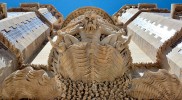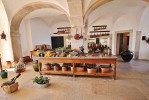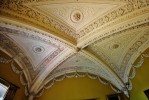- #PT5
- Estrada da Pena, 2710-609 Sintra, Portugal
- +351219237300
- info@parquesdesintra.pt
- https://www.parquesdesintra.pt/en/
- 38.7875823, -9.3906085 Copy to clipboard Copy
-
#Castles , #Family time , #Museums
This relatively young castle is unlike any other building in the world. Pena Palace included in the TOP-20 rating of the most beautiful castles in Europe. Together with other palaces of the city of Sintra, it is listed in the UNESCO cultural heritage list. The castle is also considered one of the seven wonders of Portugal.
Slightly below the complex, on the hills of the Sierra da Sintra mountain range, you can see the outlines of other palace buildings and castles of Sintra, even lower in the valley - the small town itself, further - Lisbon, and on the horizon - the Atlantic Ocean. Such dizzying views are opened to visitors by the fabulous residence of the Portuguese kings from a wooded cliff above Sintra. The castle is located 450 meters above sea level; above it (528 m), there is only a cross on the neighbouring peak.
A wonderful park garden stretches along the hill to the very foot of the palace. Here you can relax after a tour of the castle, in which you feel, at least, a hero of Disney cartoons: either a fairy-tale prince or a sea pirate, on a short vacation, looking out for objects to apply his forces in the sea.
A bit of history
Kings have long loved the places around the current Pena castle in Sintra, and they often made pilgrimages to the highest of the local hills. Back in the Middle Ages, when Portugal gained independence from the Aragonese kingdom, the chapel of Our Lady of Pena appeared here, then in its place - a monastery in the Manueline style.
Its history is tragic: at first, the structure significantly damaged by a lightning strike, and a little later, during the earthquake of 1755, only ruins remained from the Jeronymite monastery. They stood intact for over a century until the ruling royal family bought the land in 1838. King Ferdinand II decided to build a summer residence in their place. In 1840, a park laid here, and then construction began.
What came out of this, we can also see after almost two centuries. The German architect Ludwig von Eschwege revealed to the world towers and arches, minarets and domes - Eastern and Moorish styles, Renaissance and Gothic, interspersed with the same Manueline, not all the types mixed and entangled in this eclectic architectural style. As a result, we got a specific example of the romantic architecture of the 19th century with elements of the pseudo-medieval period. Passion for the exotic is characteristic of the era of romanticism.
Of course, Ferdinand II and Maria II contributed to the project and did much according to their wishes. The royal family financed the project and oversaw the construction work. Pena Castle in Portugal took 12 years to build. The royal couple had 12 children, and after the death of his wife (1853), Ferdinand married again in 1869 to the actress Eliza Hensler, who was granted Countess d'Edla before the wedding.
Various works on the arrangement and constant improvement of buildings and territory were carried out without interruption for many years until Ferdinand's death in 1885.
The Countess d'Edla inherited the palace, but in 1889 it became the state's property: the heiress sold it, yielding to the urgent requests of the new king of Portugal, Louis I.
After that, members of the royal family often visited here, and Pena castle became the summer residence of the last queen of Portugal, Amelie d'Orléans. Here she lived with her children and her husband, King Carlos I.
And in 1908, King Carlos and the eldest son of Amelie (grandson of Ferdinand II) were killed by terrorists in the very centre of the Portuguese capital. Two years later, during the revolution, the youngest son, King Manuel II, also lost his throne. The royal family left Portugal and their favourite residence - Pena Castle in Sintra.
The palace becomes the National Museum (Palácio Nacional da Pena). All the interiors in which the last royal dynasty lived preserved here.
There is another palace in Sintra where the monarchs of Portugal lived. If possible, take the time to examine it.
Palace architecture
Bright, like a patchwork quilt, the colours of the castle walls: yellow, red, terracotta, brown and grey, which we see now in reality and replicated on various souvenirs, appeared only a quarter of a century ago 1994.
Previously, the palace was monochrome. But this did not diminish its architectural merits in the least; it always looked impressive. Many photos of Pena Palace in Portugal, taken from different sides, show how its walls and base rest on huge rocky boulders.
In the construction of the palace, four main parts (areas) are distinguished:
-
The perimeter walls have two doors, one next to the drawbridge.
-
The body of the castle: a former monastery, slightly downhill at the very top of the hill. There is also a clock tower and characteristic battlements.
-
Courtyard: located opposite the chapel with arches in the wall. The arches are in the neo-Moorish style.
-
The palace itself: a colossal bastion in the form of a cylinder.
The ramp leads to the palace and ends at one of the doors of the circumferential wall - the door of the Alhambra. Through it, visitors get to the Terrace, and it is from here, there is a beautiful view of the famous High Cross. The Arc de Triomphe leads to the living quarters. The newt arch leads visitors to the Tunnel of the newt and then to the Terrace of the newt. The views of the eastern part of the Pena Palace park and photos of landscapes in good clear weather from this point are magnificent. And the pictures of the castle itself and the surroundings are bright and colourful. The clock tower and chapel are the restored remains of the medieval monastery of the Jeronimites.
Suppose the time of the excursion fell on a cloudy day, and the winds from all sides blew the castle and drowned the surroundings in fog. In that case, you also need not despair - a romantic atmosphere in the entourage of 18th-century architecture is guaranteed!
On the terrace, you can dine and, having refreshed, continue your excursion through the halls of the palace inside the bastion.
There are more than a dozen of them here. The basis of various collections: samples of antique furniture, collections of antique branded porcelain and fine ceramics, skillful stained-glass windows by famous masters, elaborate chandeliers, and many other interior items.
But the interiors themselves in almost all the rooms are typically Portuguese: there is a lot of wood in each room, and the azulejo tiles on the floor and walls painted in a special technique with tiles measuring 14x14 cm.
The largest room in the palace is the royal kitchen. Two ovens on it are original, and the third restored.
The authentic (19th century) chandelier of the Smoking Room made with plant motifs.
Muhader is the name of the style that decorates the ceiling and walls of the Smoking Room. It is the first large room from which the construction of the bastion part of the palace began. The furniture was brought from India in the 40s of the last century.
The chambers of King Carlos I, set up in the former home of the abbot of the Jeronymite monastery.
Queen Amelie's chambers on the upper floors of the palace.
At first, the ambassadors were received in the large hall, and then it was adapted into a billiard room.
The lacy ceilings of the halls of the palace are admirable.
Authentic copper crockery bears the original palace markings and the dining service collections of porcelain embossed with the coat of arms of Ferdinand II.
On the castle's territory, various thematic exhibitions of collections from the museum's storerooms often held. The ticket price for visiting the Pena Palace from Sintra (Portugal) also includes an inspection of their exposition.
The President of the Portuguese Republic and other government officials sometimes use the Pena National Palace to receive foreign delegations.
The park
The best view of the palace opens from the park from the statue of Ferdinand II, the host king of the castle. To get there, you need to climb up the boulders. Of course, shoes and clothes should be comfortable and safe.
According to the wishes of Ferdinand II, the park at the foot of the Pena castle designed as a romantic garden of those times. There are many stone pavilions and stone benches throughout the territory. Winding paths lead to each. Rare species of trees from different world countries and the most exotic plants are planted and grow throughout Pena Park. The local climate allowed them to acclimatize quite easily and take root forever.
No one can bypass a huge forest area of 250 hectares at a time (which is about 120 football fields!). And in truth, many tourists admit that after examining the palace from the outside and the inside, there is almost no energy left for the park. So for those interested in botany and landscape park architecture, it makes sense to set aside a separate day to view it.
Here you will find everything: waterfalls, ponds and ponds, fountains and lakes. The water system of the entire park is interconnected, and a variety of architectural and decorative objects scattered around its perimeter. The many interesting viewpoints of the park around Pena Palace shown on the map, which is best to take with you on this mini-trip.
There are two pavilions at the entrance to the park and behind them begins the Queen Amelie garden. You can go to the dovecote to view the 3D model of Sintra exhibited here.
Take a walk through the alleys of the Camellia Garden and see the royal Fern Valley.
They are not local varieties, but Australian and New Zealand ones, but they took root well because they acclimatized in the Azores before they cultivated here.
How to get from Lisbon
Several trains per hour (line CP) leave from stations:
Oriente, Rossio, Entrecampos
Travel time to Sintra from 40 minutes. up to 1 hour, fare 2.25 euros (website www.cp.pt). Further from the railway station by bus number 434 of the Scotturb company for 3 euros (5.5 euros round trip). The distance to the palace complex is 3.5 km, and the road goes steeply uphill.
By car: take the IC19 highway—the navigational coordinates of the Pena Palace in Sintra.
If you are already in the historical centre of Sintra and prefer unhurried walks through its palaces and parks, then this complex can be reached by hiking trails:
From the Moorish Palace (Percurso de Santa Maria), you are breaking 1770 meters in about an hour.
From Percurso da Lapa at a calm pace in 45 min. 1450 meters .



















